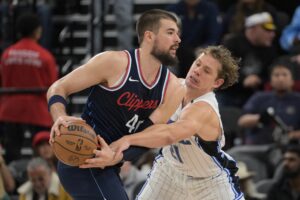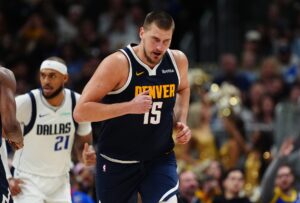Welcome back to LWOS NBA Draft Coverage, the column that brings you player profiles for the next crop of professional basketball players that are likely to be selected in the upcoming draft. Be sure to bookmark the site, follow us on Twitter, and spread the word for the site that will bring you analytical profiles and scouting reports. Check out our complete coverage of the 2017 NBA Draft. Last Word On Sports is your new headquarters for all things 2017 NBA Draft.
This Lonzo Ball NBA Draft profile looks at one of the top prospects in this year’s class.
Lonzo Ball – 6’6” Point Guard, UCLA, 19 Years Old
One of the most hyped players in the upcoming NBA Draft is Southern California native Lonzo Ball. The buzz around the 19-year-old point guard is warranted. He is a uniquely skilled player who nearly single-handedly transformed a struggling UCLA basketball program into an offensive juggernaut and legitimate title contender over the course of just one year.
Ball averaged 14.6 points, 7.6 assists, and 6.0 rebounds per game for the Bruins during the 2016-17 season, leading them to a 31-5 record. A highly gifted passer, Ball also led the nation in assists. He was voted Pac-12 Freshman of the Year, named First Team All-Pac-12, and earned consensus First Team All-American honors. Ball was also awarded the Wayman Tisdale Award as the top freshman in the nation. He was the only freshman recognized as a finalist for the John R. Wooden Award, Naismith College Player of the Year Award, and Oscar Robertson Trophy.
Ball and the Bruins made it as far as the Sweet 16 before falling to the very talented Kentucky Wildcats in the NCAA tournament’s South Regional semifinal, 86-75. Ball declared his intention to enter the 2017 NBA Draft in the locker room immediately after the loss.
Strengths
Ball is best known for his passing skills. He excels in transition and can also spread the floor. He is a pure point guard with size, speed, and exceptional playmaking abilities. At 6’6”, Ball has the ability to see the entire floor, reads defenses with ease, and is excellent at finding open teammates and distributing the ball.
The versatile point guard can also shoot the lights out. At UCLA, Ball made 55.1 percent of his field goals and 41.2 percent of his shots from behind the arc. His effective field goal percentage for the season was 66.8 percent. These are, without question, elite numbers.
Weaknesses
Ball has an unorthodox shooting form. He’s a right-hander who brings the ball up and across his body to release from the left shoulder. This shooting style may not be as effective for Ball in the NBA as it was for him in the NCAA. When playing against the NBA’s elite defenders, Ball’s unique release will put him at higher risk of being stripped or blocked and will continue to hamstring him in ways that will impact his overall success. For example, the hitch from right to left in Ball’s technique has made it hard for him to shoot off the dribble going to the right. This difficulty will only continue as he faces better defensive players.
Ball also has a tendency to dribble loose and high. This makes him a turnover risk and – along with his odd shot release – will compromise his effectiveness in isolation situations. Unlike Stephen Curry, Ball will not be the go-to guy with time running out in a half-court set. His ability to get to the rim in such situations is questionable.
Defensively, Ball is mediocre. He’s got the build to develop into an elite defender, and he has demonstrated good instincts and the ability to block shots. However, for a point guard, his lateral movement and reactivity could be better. Until he develops a more explosive and reactive first step, Ball will undoubtedly spend a lot of his rookie year being burned by the league’s best ankle-breakers.
His Father
Perhaps Ball’s most obvious and talked about weakness has nothing to do with his skill-set. It’s his loud-mouthed and polarizing father, LaVar Ball. The elder Ball, who some might describe as a marketing genius, has been a story in the media non-stop for months. He’s made outlandish and controversial comments, and he’s shamelessly hawked the Ball family’s “Big Baller Brand” (including slides that can be yours for only $220).
Last Friday, LaVar boldly declared that Lonzo doesn’t have any reason to take advice from former Los Angeles Laker and future Hall of Famer Kobe Bryant. Meanwhile, well-established current NBA stars, including Paul George and Kyrie Irving, are actively seeking out the Mamba for guidance. On Wednesday, LaVar appeared on The Herd with Colin Cowherd to promote himself and his brand. The older Ball ended up in an argument with the show’s co-host, Kristine Leahy. He’s since been criticized as being both obnoxious and misogynistic. Some franchises may not want to deal with the headache and distraction that accompanies signing Lonzo vis-à-vis his father. Others may be willing to deal with it, given the younger Ball’s exceptional talent. Only time will tell.
NBA Potential
Luckily, Ball is a smart basketball player with a temperament that is the polar opposite of his father’s. He seems equipped to deal with the pressure and target that has been put on him, and he’s likely to enjoy a lot of success in the NBA.
In terms of next month’s draft, Ball is too talented not to be a top-three pick. He and Kansas’ Josh Jackson seem like the favorites to be the second selection, behind the University of Washington’s Markelle Fultz. Kentucky’s De’Aaron Fox and Duke’s Jayson Tatum are expected to round out the top five.
Ball would best fit with a team that can build around him and his style of run-and-gun basketball. It would be a young group without a strong existing face or identity. The rebuilding Los Angeles Lakers, Ball’s “desired destination,” would be ideal. With the Lakers getting the second overall pick in yesterday’s draft lottery – much to the Ball family’s delight – we may very well see Ball wearing purple and gold next season.
NBA Comparisons
Ball is a unique talent but has frequently been compared to ten-time NBA All-Star Jason Kidd. Until Ball’s recent performance at UCLA, Kidd was the last player in the Pac-12 conference to average at least 14 points, seven assists, and six rebounds in a season. Kidd’s accomplishment came in 1993-94 with the UC Berkeley Golden Bears. Ball’s 274 assists also passed Kidd (272) for the second-most in a season by a Pac-12 player, behind only Ahlon Lewis (294) of Arizona State (1997–98 season). Ball is a better shooter at this juncture than Kidd was, though. Kidd shot 47 percent from the field and 36 percent from three-point range as a sophomore, an improvement on 46 and 29 percent, respectively, from his freshman season.
All statistics courtesy of http://www.sports-reference.com/cbb/
Main Photo:






